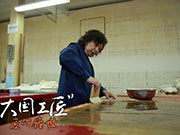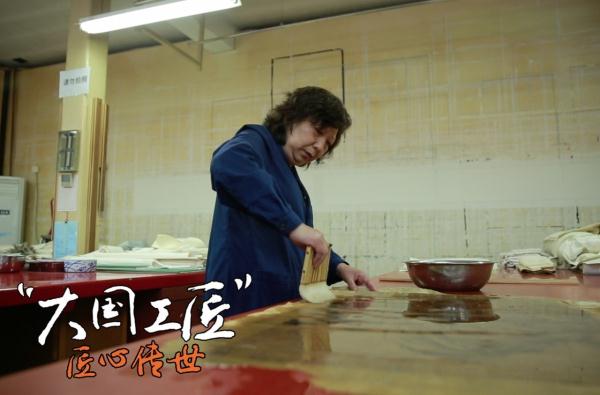The painstaking labors of a museum restorer

 0 Comment(s)
0 Comment(s) Print
Print E-mail CNTV, May 4, 2016
E-mail CNTV, May 4, 2016
It's not a way to get rich, but it is a calling of great value. Shan Jiajiu is restoring a calligraphy work by Qing-dynasty emperor, Qianlong, who was both artist and collector.
 |
|
The painstaking labors of a museum restorer |
"Emperor Qianlong was very concerned with the mounting of pictures. He always gave instructions on how many pine trees and how many cranes should be drawn by the side," she said.
Shan told us, to restore a work like this will take about four months.
"The most important thing for us is to have a calm heart and patience. You can only repair several paintings or calligraphy works a year. The work can not be done in a hurry. If you are in a bad mood, or the work isn't done smoothly, you should stop doing it, because a wrong move would harm the whole piece. It's irreversible," she said.
Shan has walked this path for 38 years. The Palace Museum is thronged with visitors every day, Shan's department is located by a serene courtyard, set apart from the hustle and bustle.
Shan's apprentice, Yu Li, outlines the journey of a young restorer.
"I have been here for two and a half years, but I haven't renovated a single piece because my master told us that only after being an apprentice for three years can we start to do it on our own. So my job is doing preparations such as stirring pastes or scraping paper. What I learn from her is not only the techniques but also the responsibility of restoring the ancient relics," Yu said.
In this case, Shan is repairing an ancient landscape painting. The first step is to rinse the painting using warm water in order to remove layers of paper attached to the back of the painting.
"This back paper was made during Emperor Qianlong's reign. The skill of making it has been lost. So we'll keep it for renovating relics. The hardest step is to remove the last layer which is directly attached to the painting. It's only 0.22 millimeters thin. We remove this layer by rubbing it," Shan said.
Three days later, Shan successfully removed the layer.
"Every time when I finish repairing a work, I have a sense of accomplishment. This is a conscientious job - not one for slackers," she said.
This Ming-dynasty silk painting depicting two cranes took four months of mending. There is a shortcut method - attaching a whole piece of silk to the back of the painting - which can be done in a few days, but Shan has opted instead to align the threads both horizontally and vertically.
"If I did it that way, hundreds of years later, the silk I attached and the painting would be sticking together as one piece. Then, there would be no way to repair it again. This method would be scolded by our descendants. It's not easy to pass down an ancient relic from one generation to the next, but it's our responsibility to do so. It should not be destroyed at our hands," she said.
Shan inherited her zeal for restoration from her father, who worked in relics protection at the Palace Museum for 70 years. But integrity in the job precludes being a collector.
"My father didn't allow us to collect relics, so I've never been to the antique market. If you're a relic collector, and you're seeking some relics or materials from a certain period, you might be tempted to steal some from the museum. So I don't touch that trade," she said.
Apart from restoring the relics herself, Shan is dedicated to nurturing the next generation of restorers.
She looks forward to travelling the world after she retires. For now, though, there is more than enough to keep her occupied in Beijing!





